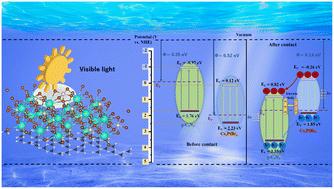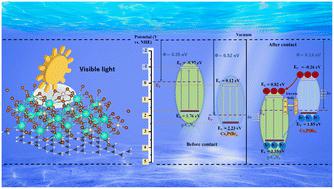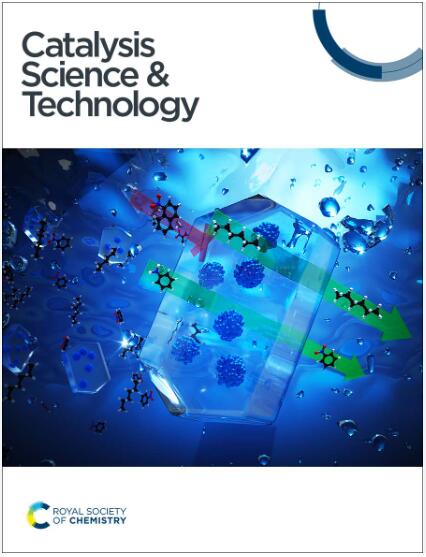通过密度泛函理论计算深入了解 g-C3N4/Cs2BBr6 (B = Pt、Sn、Ti) 异质结光催化剂的光催化机理
IF 4.4
3区 化学
Q2 CHEMISTRY, PHYSICAL
引用次数: 0
摘要
在所有经过深入研究的光催化剂中,g-C3N4 在各个领域都引起了极大的研究兴趣。然而,未经改性的 g-C3N4 中光生成的电子-空穴对的重组率很高,导致光催化效率下降。在实际应用中,通常需要引入适当数量和类型的表面助催化剂,以提高 g-C3N4 的光催化活性。g-C3N4 与过氧化物材料之间的异质结可促进电荷的有效分离,从而在保持光催化剂稳定性的同时提高光催化性能。近年来,无铅卤化物双包晶石(如 A2BX6)已被广泛应用于光催化领域。在本研究中,我们利用密度泛函理论(DFT)计算对 g-C3N4/Cs2BBr6(B = Pt、Sn、Ti)异质结的能带结构和电荷转移进行了系统研究,并探讨了 Cs2BBr6(001)表面与 g-C3N4 之间的相互作用。结果表明,g-C3N4/Cs2PtBr6 和 g-C3N4/Cs2SnBr6 异质结呈现交错能带排列,这有利于光生电荷载流子的迁移并提高催化活性。此外,g-C3N4/Cs2TiBr6 异质结还表现出跨带间隙。此外,对状态密度、电荷密度差和 Bader 电荷的分析表明,内部电场的存在促进了异质结界面上电子-空穴对的分割,有效抑制了电荷载流子的重组。因此,根据 g-C3N4/Cs2BBr6 结构中 B 位的特定金属离子,所产生的异质结将表现出不同的带排列和光催化性能。这项研究为设计新型高活性异质结光催化剂提供了理论依据。本文章由计算机程序翻译,如有差异,请以英文原文为准。


Insights into the photocatalytic mechanism of g-C3N4/Cs2BBr6 (B = Pt, Sn, Ti) heterojunction photocatalysts by density functional theory calculations†
Among all well-studied photocatalysts, g-C3N4 has attracted significant research interest in various fields. However, the recombination rate of photogenerated electron–hole pairs in unmodified g-C3N4 is high, leading to a decrease in photocatalytic efficiency. In practical applications, it is often necessary to introduce appropriate amounts and types of surface cocatalysts to amplify the photocatalytic activity of g-C3N4. The heterojunctions between g-C3N4 and perovskite materials can facilitate efficient charge separation, leading to improved photocatalytic performance while maintaining the stability of the photocatalyst. In recent years, lead-free halide double perovskites, such as A2BX6, have been widely applied in the field of photocatalysis. In this study, we conducted systematic investigations on the band structures and charge transfer of g-C3N4/Cs2BBr6 (B = Pt, Sn, Ti) heterojunctions using density functional theory (DFT) calculations, and explored the interaction between the Cs2BBr6(001) surface and the g-C3N4. The results show that the g-C3N4/Cs2PtBr6 as well as g-C3N4/Cs2SnBr6 heterojunctions exhibit staggered band alignment, which facilitates the migration of photogenerated charge carriers and enhances catalytic activity. Besides, the g-C3N4/Cs2TiBr6 heterojunction exhibited a straddling gap. Furthermore, the analysis of density of states, charge density differences, and Bader charges reveals that the presence of an internal electric field promotes the partition of electron–hole pairs at the heterojunction interface, effectively suppressing the recombination of charge carriers. Therefore, depending on the specific metal ions at the B site in the g-C3N4/Cs2BBr6 structure, the resulting heterojunctions will exhibit different band alignments and photocatalytic performances. This work contributes to providing theoretical insights for the design of novel high activity heterojunction photocatalysts.
求助全文
通过发布文献求助,成功后即可免费获取论文全文。
去求助
来源期刊

Catalysis Science & Technology
CHEMISTRY, PHYSICAL-
CiteScore
8.70
自引率
6.00%
发文量
587
审稿时长
1.5 months
期刊介绍:
A multidisciplinary journal focusing on cutting edge research across all fundamental science and technological aspects of catalysis.
Editor-in-chief: Bert Weckhuysen
Impact factor: 5.0
Time to first decision (peer reviewed only): 31 days
 求助内容:
求助内容: 应助结果提醒方式:
应助结果提醒方式:


